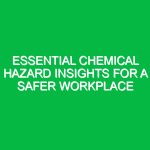Understanding Biohazards in the HSE Context
Biohazards refer to biological substances that pose a threat to the health of living organisms, primarily humans. This includes a range of materials such as bacteria, viruses, fungi, and other microorganisms that can cause diseases. In the Health, Safety, and Environment (HSE) domain, understanding and managing biohazards is crucial not only for compliance with regulations but also for the safety and well-being of employees and the surrounding community.
The relevance of biohazards in the workplace has gained heightened attention in recent years, particularly in light of global health crises. Organizations across various sectors are urged to implement stringent safety protocols to protect their workforce from potential exposures. This article aims to provide comprehensive insights into critical biohazard safety measures, offering essential tips for maintaining a secure workplace.
Key Aspects of Biohazards in the Workplace
Types of Biohazards
Biohazards can be categorized into four main groups, each with distinct characteristics and risks:
- Biological Agents: These include bacteria, viruses, parasites, and fungi that can lead to infectious diseases. For example, Staphylococcus aureus can cause skin infections, while influenza viruses can lead to respiratory illnesses.
- Allergens: Substances that can trigger allergic reactions, such as mold spores and certain proteins, pose significant risks in workplaces where exposure is possible.
- Toxins: Some organisms produce harmful toxins that can affect human health. For instance, certain strains of Clostridium botulinum produce a potent neurotoxin.
- Human Pathogens: These are infectious agents that can be transmitted from one individual to another, such as HIV and hepatitis viruses.
Understanding these categories is pivotal for implementing appropriate safety measures and ensuring compliance with HSE regulations.
Potential Risks and Safety Considerations
With the presence of biohazards comes an array of risks that can affect both employee health and organizational operations. Key risks include:
- Infection Spread: Exposure to biohazards can lead to outbreaks of infections within the workplace, impacting productivity and leading to potential public health crises.
- Legal Consequences: Failing to comply with biohazard safety regulations can result in legal action, significant fines, and damage to an organization’s reputation.
- Psychological Impact: The fear of exposure to biohazards can lead to stress and anxiety among employees, resulting in decreased morale and productivity.
To mitigate these risks, organizations must prioritize biohazard safety, fostering a culture of health and safety within the workplace.
Essential Tips for Managing Biohazards
Establish Comprehensive Safety Protocols
Creating detailed safety protocols is the foundation of effective biohazard management. Here are crucial steps to consider:
- Risk Assessment: Conduct thorough assessments to identify potential biohazard risks specific to your workplace. This involves evaluating the types of biological agents present, their modes of transmission, and the likelihood of exposure.
- Training Programs: Implement ongoing training programs for employees to ensure they understand biohazard risks and the proper handling procedures. Regular drills can reinforce safety practices.
- Standard Operating Procedures (SOPs): Develop clear SOPs for handling biohazardous materials, focusing on containment, decontamination, and disposal methods.
By establishing comprehensive protocols, organizations can create a robust framework for biohazard safety.
Utilize Personal Protective Equipment (PPE)
PPE is a critical line of defense against biohazard exposure. The selection of appropriate PPE should be based on the specific biohazard risks identified. Common PPE includes:
- Gloves: Nitrile or latex gloves provide a barrier against contamination when handling biohazardous materials.
- Face Masks: Surgical masks or N95 respirators can protect against airborne pathogens.
- Gowns and Lab Coats: These protect the skin and personal clothing from potential biohazard exposure.
- Eye Protection: Goggles or face shields safeguard against splashes or aerosolized particles.
Proper training on the correct use and disposal of PPE is essential to maximize its effectiveness.
Implement Safe Waste Disposal Practices
Biohazardous waste must be disposed of in compliance with local regulations and guidelines. Here are best practices for safe waste disposal:
- Segregation: Clearly label and segregate biohazardous waste from regular waste to prevent cross-contamination.
- Use of Red Bags: Biohazardous materials should be placed in designated red bags that indicate their hazardous nature.
- Contract Licensed Waste Disposal Services: Collaborate with licensed waste disposal companies that specialize in managing biohazardous waste.
Adhering to these practices not only ensures compliance but also protects the environment and public health.
Regular Monitoring and Audits
Continuous monitoring and auditing of biohazard safety practices are essential for maintaining a secure workplace. This includes:
- Routine Inspections: Conduct regular inspections of work areas to identify potential biohazard risks, ensuring compliance with established safety protocols.
- Health Surveillance: Implement health surveillance programs to monitor employee exposure to biohazards and assess any health impacts.
- Feedback Mechanisms: Establish channels for employees to report safety concerns or suggestions for improving biohazard management.
By fostering a culture of accountability and vigilance, organizations can enhance their biohazard safety strategies.
Regulations and Standards Governing Biohazards
Understanding the legal landscape surrounding biohazard safety is crucial for compliance and operational integrity. Key regulations include:
- Occupational Safety and Health Administration (OSHA) Standards: OSHA outlines specific regulations pertaining to bloodborne pathogens (29 CFR 1910.1030) and general duty clauses that mandate safe working conditions.
- Centers for Disease Control and Prevention (CDC) Guidelines: The CDC provides guidance on safe practices for handling biohazards, particularly in healthcare settings.
- Environmental Protection Agency (EPA) Regulations: The EPA governs the disposal of hazardous waste, including biohazardous materials, ensuring environmental protection and public safety.
Compliance with these regulations is not just a legal obligation; it is integral to promoting a culture of safety and accountability within the workplace.
Conclusion
In an era where biohazard safety is more critical than ever, organizations must proactively address the risks associated with biological agents. By implementing comprehensive safety protocols, utilizing appropriate PPE, and adhering to regulatory standards, workplaces can significantly reduce the threat posed by biohazards.
The importance of biohazard management transcends legal compliance; it fosters a culture of health and safety that protects employees, the environment, and the broader community. As we navigate an increasingly complex health landscape, prioritizing biohazard safety is not just a responsibility but a commitment to ensuring a secure and sustainable workplace.
Encouraging ongoing education, vigilance, and innovation in biohazard management will pave the way for healthier and safer work environments. Organizations are called to take a proactive stance, continuously adapting and enhancing their biohazard safety measures to meet evolving challenges and protect their most valuable asset: their people.


